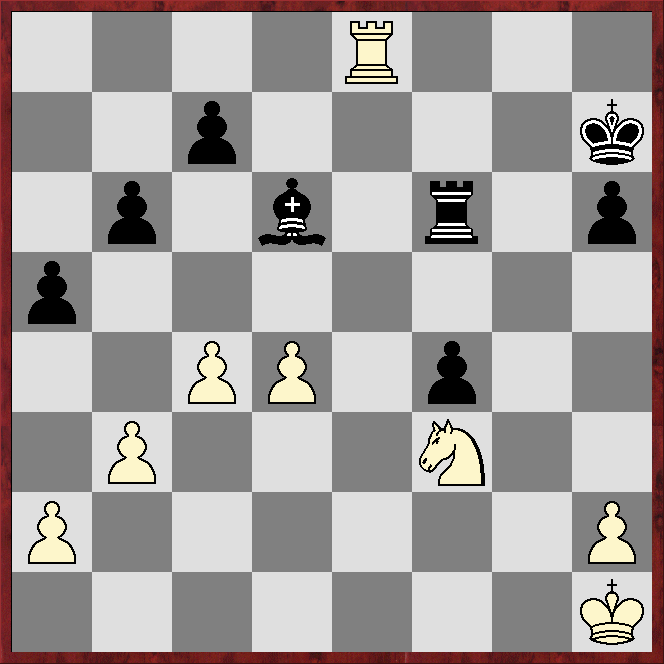Early on, in Chicago, he essayed the King's Gambit, but this time played 3.Nf3 instead of his usual 3.Bc4, and found himself facing his own Bust.
Fischer - Kenneth Mott-Smith
Chicago (simul) 1964
King's Gambit
1.e4 e5 2.f4 exf4 3.Nf3 d6 4.d4!?
This is the move that Fischer had said in his article for The American Chess Quarterly would transpose into 4.Bc4 lines.
4...g5 5.Bc4!?
Joe Gallagher in Winning With The King's Gambit (Batsford 1992) called this illogical, explaining: "If White wants to play this he should play it on the fourth move, as then Black is forced to play ...h6." Gallagher mainly covers 5.h4, which was dismissed by Fischer in a note to 4.Bc4.
5...h6!?
This is by no means forced, but it may well be that Mott-Smith was determined to play Fischer's 'refutation'.
*****
*****
*****
*****
6.0-0 Bg7 7.c3 Ne2!?
As I mentioned here, Fischer devoted most of his attention in the article to the known move 7...Nc6, but in a note annotated the text with "(!)" and said he felt it was best.
8.g3 Ng6!?
Preparation or memory slip (Fischer in his Bust article had only covered 8...d5!?, to which he awarded an exclamation mark)? I have not been able to discover much about Mott-Smith, except that he was a lawyer who represented the US in a cable match against Britain, and beat Emanuel Lasker and Alexander Alekhine in simuls in the mid-1920s.
9.Qb3?!
Stockfish16 and Komodo14.1 reckon 9.Ne1!? more-or-less equalises.
9...0-0
Fischer had written that the point of ...Ne2 is to strive to castle kingside, which is what Black has now achieved. If White had played the engines' 9.Ne1!?, then 9...0-0 could be answered with 10.gxf4, regaining White's sacrificed pawn.
10.gxf4 gxf4
 |
| Black's extra pawn is doubled and isolated, but it does a useful job in obstructing White's dark-square bishop |
*****
*****
*****
*****
11.Kh1 Nc6 12.Qc2 Nce7!? 13.Nbd2 Be6
Making this possible was the point of 12...Nce7!?, but the engines prefer 13...d5.
14.Rg1 Bxc4 15.Nxc4 d5 16.Nce5 dxe4 17.Qxe4 Qd5 18.Qxd5 Nxd5 19.Nxg6 fxg6 20.Rxg6
*****
*****
*****
*****
The engines reckon the position is completely equal, but that does not mean it is drawish. Black has the better bishop and a passed pawn, but White has a farside pawn-majority and fewer pawn-islands, so it will be a battle of trying to use one's own advantages while seeking to exploit the opponent's weaknesses.
20...Kh7 21.Rg2 Rae8 22.Bd2 Ne3 23.Re2 Nc4 24.Rae1 Rxe2 25.Rxe2 Nxd2!?
20...Kh7 21.Rg2 Rae8 22.Bd2 Ne3 23.Re2 Nc4 24.Rae1 Rxe2 25.Rxe2 Nxd2!?
Presumably expecting the surviving bishop to work better with a rook than the surviving knight will, but the engines reckon Black should capture on b2, or play 25...c5!? and meet 26.dxc5 by capturing on b2.
26.Nxd2 Rf6!?
The engines are not keen on this either, one suggestion being 26...Rg8!? to deter Kg2. If White replies 27.Re4, hoping to induce 27...Rf8, and so allow 28.Kg2, possible is 27...Bf6!?, the idea being 28.Rxe4 Bg5, when 29.Rf2?? loses to 29...Be3, so White has to play 29.Rf7+ Kg6 30.Rf2, but then 30...Bxd2 31.Rxd2 Kf5 gives Black a much more-active king.
27.Nf3?!
Probably better is activating the king with 27.Kg2.
27...Bf8?!
The engines agree 27...Ra6 28.a3 Kg6 keeps any Black disadvantage to a minimum.
28.Re8 a5 29.b3!?
The engines suggest immediately activating the white king.
29...Bd6 30.c4 b6
*****
*****
*****
*****
Black has the generally better piece for cooperation with a rook, but the bishop is somewhat restricted by the f pawn, which is a passer but is blockaded by the knight. White has a farside pawn-majority, but getting it successfully moving does not look easy. Komodo14.1 gives White a slight edge, but Stockfish16 calls the position equal.
31.Kg2 Kg6 32.Kf2 Kf5 33.h3 Rf8 34.Nh4+ Kg5 35.Rxf8+ Bxf8
*****
*****
*****
*****
Rival pawn-majorities favour a bishop, but the bishop is not very good - every black pawn is on a dark square. The engines reckon the position is completely equal.
36.Ng2 Bg7 37.d5 Be5 38.Kf3 Kf5 39.Ne1 Bc3 40.Nd3 Be5 41.a3
Exchanging minor pieces is also equal, according to the engines.
41...Bd6 42.b4 axb4 43.axb4 Be7 44.c5 bxc5 45.bxc5
*****
*****
*****
*****
45...Bg5?
Black seems to have three drawing moves but, perversely, defending the threatened f pawn is not one of them.
A) 45...h5!? 46.Nxf4 Bxc5 47.Nxh5 is a tablebase draw.
B) 45...Bf6!? 46.Nxf4 Ke5 is also a draw, according to the engines.
C) 45...Bf8!? is not so clearcut. Komodo14.1 reckons 46.d6!? is promising for White, but 46...Ke6 47.dxc7 Kd7 48.Kxf4, although liked by Komodo14.1, is shown by the Syzygy endgame tablebase to be drawn.
*****
*****
*****
*****
46.Nb4?
The engines show 46.c6 wins, although the winning method is not simple. The threat is 47.d6, and if Black stops that with 46...Be7, then 47.Nxf4 means the white queenside pawns cannot be touched, and so Black is helpless, eg 47...Bd6 (47...Ke5? 48.Ng6+) 48.Nd3 Be7 49.Ke3 Bd6 50.Kd4 Bh2 51.Nc5 Kf6 52.Ke4 Bd6 53.Ne6 Bh2 54.Nd4 h5 55.Nf5 Kf7 56.h4 Kf8 (56.Kf6 d6! 57.cxd6 Kd5!) 57.Kf3! Kf7 58.d6!
46...Be7?
Both 46...Ke5 and 46...Bd8 are completely equal, according to the engines, and 46...Bh4!? also probably draws, but the active text should lose.
47.Na6?
Winning is 47.d6 cxd6 48.c6, eg 48...Bd8 49.Nd5 Kg5! 50.Nxf4!, or 48...Ke6 49.Nd5.
*****
*****
*****
*****
47...Ke5?
47...Ke5?
The engines show Black holds with 47...Bd8.
48.d6! cxd6 49.c6 Bd8 50.c7 Bxc7 51.Nxc7 d5
*****
*****
*****
*****
52.Na6!
If 52.Nb5, 52.h4 or 52.Ne8, then 52...d4 draws.
52...Kf5
If 52...d4 then 53.Nb4 or 53.Nc5.
The game finished:
53.Nb4 d4 54.Nd3 Kg5 55.Nxf4 Kh4 56.Kg2 h5 57.Kh2 1-0








No comments:
Post a Comment